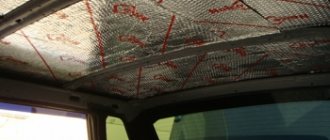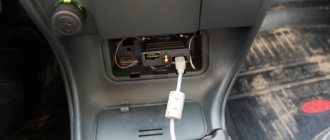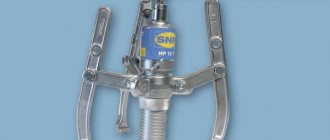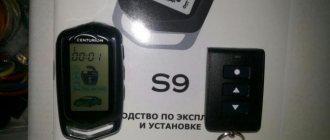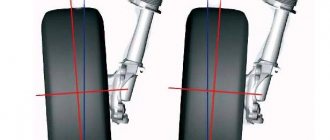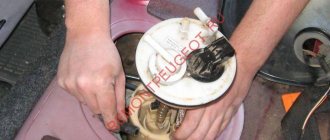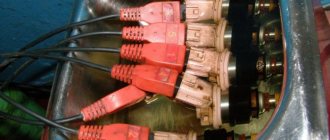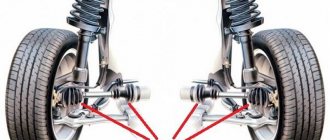Repairing the threshold is complicated by the fact that access to the reverse side of the damage is closed. In addition, the metal of the threshold, due to its design, has high rigidity and significant effort is required to straighten it.
p, blockquote 1,0,0,0,0 —>
In this article, we will look at several ways to repair damage to a doorstep. Special equipment will be required to professionally repair significant damage. If the dent is small, then you can get by with improvised means.
p, blockquote 2,0,0,0,0 —>
p, blockquote 3,0,0,0,0 —>
How do professionals straighten thresholds?
In modern body repair, when straightening deformed sills, a spotter and various pulling devices are used (for more information about these devices, see the article “Spotter”). First, the protective coating is removed from the threshold to bare metal. Then, using a spotter, pulling elements are welded to the threshold, after which the dents are gradually pulled out and simultaneous tapping of protruding places and folds around the deformation, if necessary.
p, blockquote 4,0,0,0,0 —>
p, blockquote 5,0,0,0,0 —>
p, blockquote 6,0,1,0,0 —>
p, blockquote 7,0,0,0,0 —>
p, blockquote 8,0,0,0,0 —>
p, blockquote 9,0,0,0,0 —>
The pulling sequence is carried out depending on the structure of the damage. If the threshold flange (the lowest part where the threshold connects to the bottom) is damaged, then it must be returned to its place first. Next, you need to straighten the corners of the threshold if they are jammed. Thus, the main shape of the threshold needs to be restored first, and minor irregularities are corrected last. Shallow dents can be straightened with a reverse hammer, which is included with the spotter.
p, blockquote 10,0,0,0,0 —>
Changing the pillar and threshold
If the threshold and the pillar are damaged, then it is necessary to replace the threshold and the pillar at the same time. You need to follow a simple procedure.
First, the B-pillar spar must be cut out. Before straightening the spar, you need to make sure that the car body is strong.
After this, the installation site must be cleaned, and all excess metal must be removed.
Next, the surface of the spar must be leveled and adjusted. After this, fastening, installation and welding are carried out. That's all. All that remains is to put the doors in place and adjust the gaps.
Repair if you have a welding machine
p, blockquote 11,0,0,0,0 —>
p, blockquote 12,1,0,0,0 —>
p, blockquote 13,0,0,0,0 —>
p, blockquote 14,0,0,0,0 —>
p, blockquote 15,0,0,0,0 —>
- If it is possible to attach the chain to the garage floor or other lower part (weld the loop to a metal corner, for example, that frames the inspection hole), then you can use the following method. You can weld metal loops or plates with loops to the deformed places, attach a chain to them and to the bottom of the garage and lift the car with a jack. The dent will straighten out as the jack is raised. In this way, you can straighten a jammed threshold flange, which is very rigid and not pliable when straightened.
- If it is not possible to secure the chain to the bottom of the garage, then you can do everything in the same way as in the previous point, but pass some kind of long lever (pipe or crowbar) through the chain. One end of it can be rested against the rigid part of the bottom of the car (spar along the bottom) by placing a board or block of the required thickness. The other end needs to be gradually pressed down. This way you can correct the lower deformation of the threshold. In a similar way, you can correct lateral deformation, you just need to come up with a lateral stop for the lever. For example, you can pass a board of the required length under the car, rest it against the wall of the garage, and rest the lever against its edge.
- After using welding, the inside of the threshold must be treated with an anti-corrosion agent through the technological holes in it, which are closed with rubber bands. You can spray epoxy primer through a special tube with a nozzle that sprays 360 degrees. Such a tube is usually included with Movil. If the inside of the threshold is not treated after welding, the metal will rust from the inside quite quickly.
- Before puttying, the front part can also be first coated with epoxy primer for better anti-corrosion protection. You just need to use it correctly (see the article “Using epoxy primer”).
- Next you need to putty the threshold, level the putty by sanding and prime with acrylic primer, then prepare for painting and paint.
What is this?
The threshold straightening service refers to the work of an auto repairman to eliminate the defect of a given spare part.
You may need to order such a service in the following cases:
- Presence of a dent due to an impact.
- Presence of a manufacturing defect in the form of a dent.
It is better to contact professionals for car repairs. If it is necessary to restore the geometry of the thresholds, the motorist should take a number of actions:
- Find a company that provides this type of service.
- Contact the administrator to clarify the cost and terms of cooperation.
- Come to the company or call a specialist.
- Provide the machine to a specialist for repair.
- Wait for the job to complete.
- Evaluate the result.
- Pay for the service of the master.
To align auto parts today, various tools and devices are used (for example, a spotter). The mechanic's algorithm is as follows:
- Removing the protective paint coating.
- Welding of pulling elements.
- Pulling out a dent.
- Coating the leveled area with paint and varnish.
Straightening the threshold using hot glue and a homemade pulling device
A smooth dent that does not contain sharp folds can be straightened out using a pulling device and hot glue. A similar principle is used in the adhesive system of the PDR paintless dent repair technology. You can make a pulling device yourself from wooden blocks and a long bolt with a nut and washers (see photo). The block with the bolt is glued to the deepest part of the dent, after which the bolt gradually twists and pulls the glued block along with it.
p, blockquote 16,0,0,0,0 —>
p, blockquote 17,0,0,0,0 —>
p, blockquote 18,0,0,1,0 —>
The bars that will rest against the entire part of the threshold (on both sides of the dent) must be made large enough in area so that the force is dissipated and the entire part of the threshold is not deformed. It is better to make the block that will be glued from durable wood so that it does not crack or delaminate during stretching. You can use birch. The head of the bolt, which will be on the glued side of the block, must be recessed by drilling a hole of the required diameter. This way the bolt will not interfere and will not turn while straightening the dent.
p, blockquote 19,0,0,0,0 —>
To apply hot glue, you can use either a special gun or a hair dryer. A hair dryer can also be used to heat up the glue if it has time to harden while being applied to a large area of the bar. Before gluing the block, the threshold must be thoroughly cleaned, dried and degreased. You need to pull it out slowly, pausing after tightening the bolt several times. If the glue peels off prematurely, before it is completely pulled out, then you may need to re-glue and repeat pulling out several times. You can gently tap the raised areas around the dent while pulling (if there are any).
Types of car thresholds
Before you begin repairing the threshold, you need to clearly understand what you are faced with and what leveling method you will need to use. This directly depends on the type of part installed on your car. All car thresholds can be divided into two main categories:
- Removable. Such a part can be easily removed at any time, because it is attached to the body and bottom using ordinary bolts.
- Cast. They are welded to the vehicle body at the factory and cannot be removed. Such a threshold can only be removed by cutting it out. So repairs are usually carried out without separating the part from the car.
How much does it cost on average to paint sills on a car?
Car thresholds are among those structural elements that are very often exposed to various external influences and, as a result, quickly wear out and become unpresentable. Typically, painting of such elements is carried out not only to give them a beautiful appearance, but also after repair work, it can be used as a preventive measure to protect against corrosion.
The cost of painting thresholds in the Russian Federation averages from 1,500 rubles to 2,000 rubles. This price includes payment for painter's services. Paint, varnishes and other consumables are paid additionally.
What does the price depend on?
It is worth considering that the cost of such work in most car services is calculated separately, even if the coloring of the thresholds occurs after they have been repaired. As a rule, the price depends on the area of the thresholds themselves, which translates into the amount of paint and other consumables used.
Paying for a painter will almost always be standard at any car dealership. The cost may increase depending on the make of the machine, where sometimes a more subtle approach may be required when carrying out work.
Types of painting, their cost
First of all, it is worth considering that thresholds can be removable and non-removable, based on which two categories of work are formed:
- Painting the removable threshold. When the part that needs painting can be easily detached from the main body, the work is carried out quickly and easily. The painting process itself is extremely simple: unscrew the part, straighten it, carry out a set of preparatory work and start painting;
- Painting the permanent threshold. This situation is not convenient: due to contact with the body, straightening will have to be done either from the inside or from the outside. If the alignment can only be done from the inside, then you may have to remove the doors and seats and get rid of the seals in order to have the necessary access to the threshold from the right side. After the threshold is cleaned and processed “to metal”, puttying is carried out followed by priming. Only after this should the working color be applied directly.
The painting itself can be local and with a transition. In the first case, only the thresholds are painted when the applied color has a “factory” effect. In the case of a transition option, adjacent elements are additionally painted to balance the difference in color. With this option, the costs for the consumables used will be slightly higher than in the first case.
An example of pricing for a service
All costs for painting car sills are indicated when the car is delivered to the workshop. The price for the painter’s work is immediately indicated. Then the specialists inspect the work site itself and find out whether straightening is necessary, or whether painting work can begin immediately.
Depending on the model of the car, the price may increase, since in some foreign cars it is necessary to carry out a whole range of additional preparatory work before painting.
Where can I order the service?
Many car enthusiasts try to cope with painting thresholds on their own, which often leads to disastrous results. Such work contains many subtle points, mainly in the preparatory stages, the violation of which can only cause a defect in the thresholds, and as a result, you will have to buy a new structural element, which is much more expensive. It is for this reason that it would be preferable to turn to specialists at service stations who, over ten years, have managed to learn all the nuances when executing such orders.
Moreover, by ordering a simple painting from a car repair shop, professionals can detect hidden defects in the design that the car owner did not notice, and quickly solve the problem on the spot. In any case, ordering the painting of thresholds at a specialized service station will be much more economical and profitable than paying off the high costs of the negative consequences of self-repair.
skolkos.ru
Leveling out dents on a removable threshold
Repairing damage to a removable threshold is much easier. For this type of work you will need:
- a workbench or flat base plate on which straightening will be done;
- set of tools for straightening. It includes all kinds of hammers (soft and hard), planes and chisels for straightening;
- grinder and welding machine or pneumatic chisel.
To level out a dent on a car's removable threshold, proceed as follows:
- disconnect the damaged part of the car. To do this, you just need to screw in all the fastening bolts that held it in place and carefully pull out the part;
- install the damaged threshold on the workbench;
- using hammers and other tools for straightening metal products, carefully bend all the irregularities in the opposite direction;
- treat the entire threshold with a good anti-corrosion agent;
- put the car sill in place.
Removing dents on a removable car threshold
It’s worth remembering that this method of pulling out dents on a car’s removable threshold is not universal. It is relevant only in cases where the threshold is not too damaged and can be returned to its original state with hammer blows.
However, if the dent cannot be repaired, or if rust has already affected it, it is better to throw away such a part and put another one in its place. The advantage of this method of leveling dents is that there is no need to paint the damaged fragment - it will retain its original color.
How much does it cost to repair a car sill dent: price issue
It is better to entrust the removal of a dent on the threshold to service station technicians who know everything about how to remove a dent on the threshold of a car. The accumulated knowledge allows them to cope with this task, and they have all the necessary tools at hand. The service station creates all the conditions for performing work at a high level, but the cost of such services is very high.
Car owners who are not willing to pay this price can find more economical options. For example, you can contact a specialist who knows how to remove a dent on a car door sill. But such a specialist does not give any guarantees, and his garage does not always have the tools necessary for repairs.
Maximum savings can be achieved by eliminating the defect yourself. This is an excellent option for those who have already taken part in similar work and who have all the necessary tools and a suitable room for work.
But it is still better to carry out repairs from specialists. If you need to correct the geometry of the thresholds, you will need to perform several steps:
- Find a company that provides similar services.
- Discuss the price and terms of cooperation with the administrator.
- Arrive at the appointed place or call a specialist to your place.
- Provide your vehicle to perform the work.
- Wait patiently for the work to finish.
- Evaluate the result obtained.
- Make a settlement with the master.
The price for such types of work varies greatly. It all depends on the following features:
- How deep is the dent?
- So many defects.
- Difficulty of work.
- What devices and tools are used.
- Do I need to paint my car?
- Straightening method.
- What material are the spare parts made of?
- Car model.
- In what time frame must the work be completed?
- Prestige of the company.
Prices (approximate) for stretching thresholds depending on the size of the defect are given below:
- A dent of no more than 3 cm - within 900 rubles.
- From 5 to 8 cm – 1,100–1,500 rubles.
- From 10 to 15 cm – 2,500–3,500 rubles.
- From 20 to 30 cm – 4,500–5,500 rubles.
- More than 30 cm – from 6,500 rubles.
The cost of straightening one threshold without painting is approximately 4,000 rubles. With painting, the same work will cost 8,000–9,000 rubles. If it is necessary to remove a spare part, it will cost another 500 rubles.
We recommend
“Restoring a car after an accident: stages, choosing a service station, nuances” Read more
Leveling out dents on a cast threshold
It is usually much more difficult to pull out a dent on a cast car sill than on a removable one. You will need more time and tools, but this work is quite doable at home. The method used to remove a dent usually depends on its size and complexity. The most popular methods are :
- Straightening using a reverse hammer. It is used to pull out small and uncomplicated dents. The principle of operation of the device is as follows: one end of the reverse hammer is not welded too tightly to the center of the dent. As the weight hits the handle, the dent will gradually level out.
Removing a dent using a reverse hammer
- If you don’t have a reverse hammer at hand, you can do the following: weld a steel plate to the dent site, then use an ice cube or with your own hands to pull it out along with the damaged part of the threshold. However, in this case, after successful completion of the repair, you will need to cut off this plate and treat the surfaces of the former dent accordingly.
- If the damage is exclusively point-like in nature, they can be corrected as follows: drill small holes in the threshold near the dent, thread special fittings with angled ends through them, and, pulling towards yourself, level out the damage. However, this method is relevant only in cases where the defects in the threshold are not large in size, and you have everything you need to immediately eliminate the holes in the threshold.
- Pulling using a vacuum suction cup. This type of damage repair is quite relevant due to the fact that it preserves the integrity of the paintwork of the car part. But it is not possible to use a vacuum suction cup in all cases. The size of the dent and its shape should approximately correspond to the dimensions of the suction cup itself - only then can it be used successfully.
The principle of operation of this unit is extremely simple: a suction cup is applied to the problem area of the threshold surface, all the air is pumped out of it, providing a reliable and soft grip.
After this, the unit is pulled out along with the surface of the threshold. These devices can be of different types, but their operating principle is always the same.
- You can also use an anvil and various hydraulic devices to pull out dents. The essence of this method is that a small rectangular window is cut out in the threshold, through which an anvil is inserted and installed opposite the dent. Then, using hydraulics, the dent can be straightened outward. In some situations, you may not need to cut a rectangular hole, but rather make cuts to the right and left of the defect. After the dent has been pulled out, all holes must be welded, treated with an anti-corrosion solution and painted (the use of paints and varnishes when implementing this method is inevitable).
How to repair it yourself without painting
Among all types of repairs, pulling out the threshold without painting is possible only in the case of slight deformation, without a sharp edge, when the paintwork is not damaged. A smooth dent without folds can be pulled out on its own in only two ways:
- using a pulling tool and hot glue;
- vacuum suction cups.
At service stations, a type of paintless body service using PDR technology is common. In this way, small, shallow deformations are eliminated. Craftsmen use special tools: levers and hammers, squeezing out a dent always occurs from the inside. When repairing a non-removable body element, it is necessary to use external tools; vacuum suction cups remain the best option. Considering that most defects are associated with damage to paintwork and metal cracks, the paintless method is not used when:
- The deformation of the metal has a sharp angle, and there is a crack in the protective coating.
- The first signs of corrosion appeared.
In case of such damage, it is necessary to carry out full surface treatment before and after reducing the dent.
How to pull out a threshold with a reverse hammer
Pulling out a threshold with a reverse hammer is considered one of the most popular and easiest ways to remove significant dents from a non-removable element. For repair you will need:
- grinding machine (grinder);
- reverse hammer;
- putty, hardener;
- sandpaper R-120, R-80;
- welding machine;
- automotive primer, degreaser;
Before work, you must remove the negative terminal from the battery and hang the car on a jack. We will look at how to straighten the threshold on a car with our own hands step by step:
- Grind the damaged area with a grinder. It is recommended to protect your eyes with goggles. When working, large grains of old paint and primer fly off.
- Clean the area with sandpaper.
- Weld the end of the reverse hammer to the threshold and begin to pull out the metal with small taps. The extraction is carried out starting from the edge of the dent.
- Weld the hammer, maintaining a distance of at least 1-1.5 cm. Walk across the entire dent, gradually pulling the metal to its original state.
You cannot start drawing immediately after welding the hammer; you must wait until the part has cooled.
- Sand the weld seams with a grinder and sand them.
- If there are any unevenness on the surface, level it with a hammer and sand it.
- Degrease and apply automotive primer.
- Dilute the putty with the hardener, treat the surface, leveling the part.
- The putty is applied with smooth, quick horizontal movements, and the protruding material is cut off.
- After complete drying, the surface is sanded with R-80 sandpaper. A second layer of putty is applied and processed in the same way.
- Auto enamel or any other protective agent is used: anti-gravel, film, etc.
Using a reverse hammer remains the most reliable way to repair permanent thresholds when deformed. It is guaranteed to be free from internal welding corrosion and is available at home.
Suction cup pulling
The use of a suction cup or vacuum hammer is justified in cases where the dent is small and repairs can be limited to without painting. However, if there is old damage, a complete surface treatment is carried out after extraction.
Drivers turn to the service station with one question: what to do if the threshold on the car is bent? Without understanding the nuances of the damage, they, as a rule, pay 70% more for the work of a tinsmith. To prevent this from happening, you need to remember: if the dent is corrected with a suction cup without additional painting, the technician spends up to 15 minutes on maintenance, and the cost of the work is calculated from time to time.
What are the defects?
According to the nature of their origin, all defects are classified as natural, mechanical. In the first category:
- erasing the coating from corrosion, paint;
- the appearance of rust from exposure to external factors;
- metal wear.
Mechanical damage means:
- dents after hitting an obstacle, from impacts with gravel;
- factory defects in paintwork, lack of corrosion protection.
The repair procedure is selected depending on the degree of damage; if corrosion has covered more than 70%, the part is completely replaced. In case of deformation, if the metal does not require cutting, it is enough to straighten it. If the outer layer of anti-corrosion is damaged without damaging the outer and inner parts of the metal, then clean it and apply protection.
Typically, drivers have to repair a part after hitting an obstacle; you can straighten the threshold on a car with your own hands if there is no internal wear of the metal.
Anti-corrosion treatment
There are two main processing methods.
The first method involves the use of auto chemicals (mastic, special varnish or impregnation).
This method is most effective if the work is carried out in a garage. But there are also negative aspects - the work requires the purchase of expensive materials.
In some cases, you can use cheap products, but they are not suitable for all foreign cars.
The second method is electrochemical protection. This method of processing should be carried out exclusively in a car workshop, where you can count on receiving a guarantee.
The peculiarity of this protection is that special electrodes are mounted on the threshold, to which direct current is supplied.
These products draw corrosion onto themselves, and not onto the thresholds. The validity period of such protection is about one year. As for the cold season, the electrodes will last a much shorter period - about three months.
Some services install regular plastic door sill covers, which have a more affordable price and are easy to change.
These overlays reliably protect the thresholds from dirt and stones, but do not protect against corrosion, which “gets” under them.
Therefore, if you are going to install such an overlay, then only after anti-corrosion treatment.
Car sills are among the most repairable parts of the body. Even with the most careful driving, drivers have to monitor the condition of the part, protect it from reagents, and check for mechanical damage from flying gravel. How to pull out the threshold on a car with your own hands at home, depending on the nature of the damage, we will analyze further and provide all the options.
Types of car thresholds
Car thresholds can be fixed or removable. The first relate to the power parts of the body; they form a single structure with the bottom, providing the base with the established rigidity. All VAZ and BMW models until 2010, Opel brands, and some cars of Japanese and Korean brands were equipped with non-removable ones.
The removable element is installed from the passenger compartment and is bolted to the bottom base. The part can be easily removed and repaired if a dent appears, the paintwork is chipped, or the first pockets of corrosion are noticeable. Removable thresholds can be easily replaced with original replicas, so in case of serious damage or cracks, the part cannot be repaired.
The straightening of a non-removable threshold is carried out by welding, drawing, straightening, and of removable ones only by straightening.
Repair of fixed parts
Structurally, the non-removable thresholds are a hollow box, the main element of which remains the amplifier, as the power part of the bottom. The external element serves to protect the body and as a decor that improves the appearance of the car.
When repairing, the car is placed on a jack or lift for the convenience of the technician. If it is necessary to cut out part of a part or use welding, then the doors and floor covering are removed. For small dents, you can pull out the threshold without painting using a reverse hammer or staples. The most common garage repairs of non-removable elements:
- sealing through holes;
- straightening;
- patch welding of the rusted area;
- anti-gravel treatment of primary corrosion areas when the seal is not damaged.
To perform repairs you will need a set of tools, equipment and the necessary skills. The complexity of the work lies in the fact that the part cannot be dismantled; if welding is carried out, it must be done directly on the car.
Repair of removable parts
This does not require much experience; it is enough to be able to straighten metal with a hammer. If drawing is carried out, the removable part can be easily secured on the machine. Correction and filling of holes on removable thresholds is carried out much less frequently than on welded ones; when plastic linings become deformed, in 90% of cases they are simply replaced with new ones. The price of new parts will not exceed the cost of services at a service station.
Do-it-yourself threshold replacement
Car body sills are sold in auto parts; they are produced for all models of passenger cars. But when replacing the gearbox, it should be taken into account that the part supplied in spare parts may differ slightly from the original gearbox in shape, and then during installation the threshold will have to be adjusted to the location. We change the front right threshold on a Volkswagen Passat with our own hands as follows (in general terms):
- I remove the negative terminal from the battery, in the area of the front right door in the cabin we remove the rug, as well as the carpet to the side;
- take an angle grinder (grinder), first cut the metal under the door in a horizontal direction;
- It is necessary to cut carefully, not to cut through too much; behind the threshold we also cut through the iron in a vertical direction;
- after sawing, take pliers, bend the iron down with your hands and a tool;
- Before working with the iron further, we remove all the dirt that has accumulated there from the internal cavity. To reach all corners, you can use tweezers;
- Having taken out all the debris, bend the metal all the way down;
- cut or break off a piece of metal to be replaced;
- dismantle the front right fender, embroider the inside of the sill;
- Before installing a new part, carefully clean the iron from rust, treat the internal cavity with Movil,
- We prime the new threshold from the inside in two layers and weld the part;
- we process the weld seam, prime the outside surface, then putty;
- sand the surface, apply another layer of finishing putty;
- We clean it with fine abrasive sandpaper, degrease the metal, and paint it with automotive enamel.
If not the entire sill is damaged or rusts, craftsmen often replace only part of the body part. But this is not always done, but only in cases where the original iron is very strong. Original parts are almost always better than those body parts that are supplied as spare parts, so installing only part of the gearbox may be advisable. It should also be noted that replacing thresholds is a complex job involving fitting parts, so it should be trusted to experienced body repair specialists.

